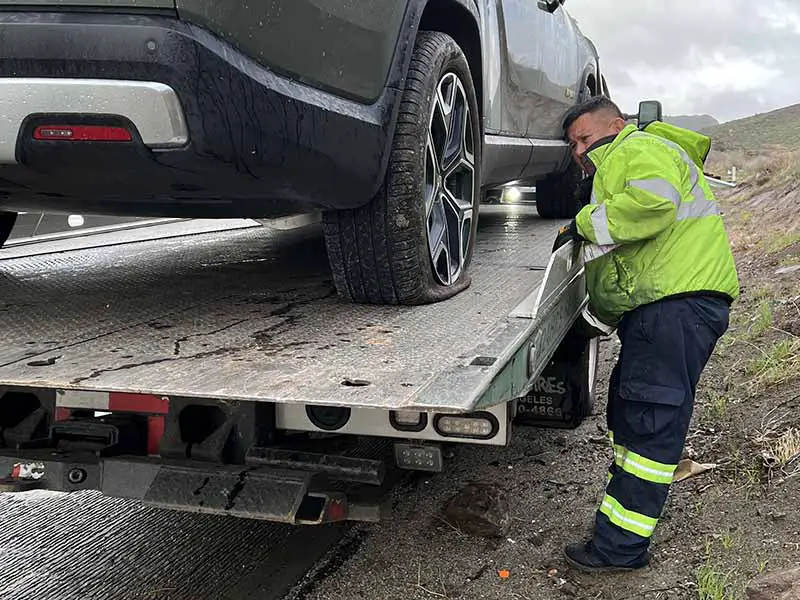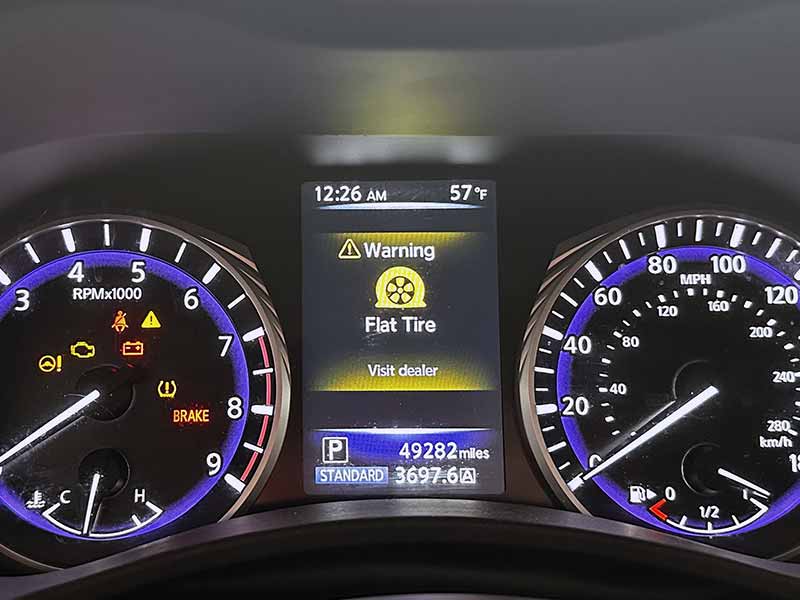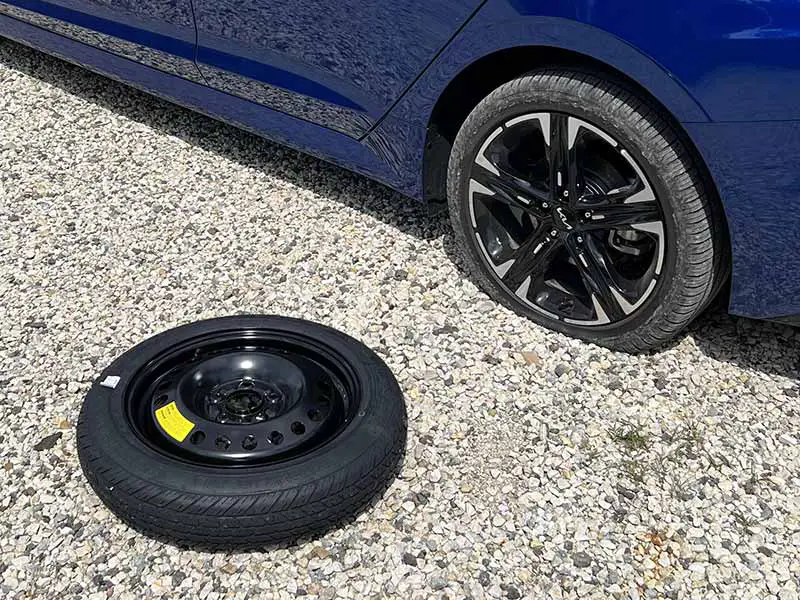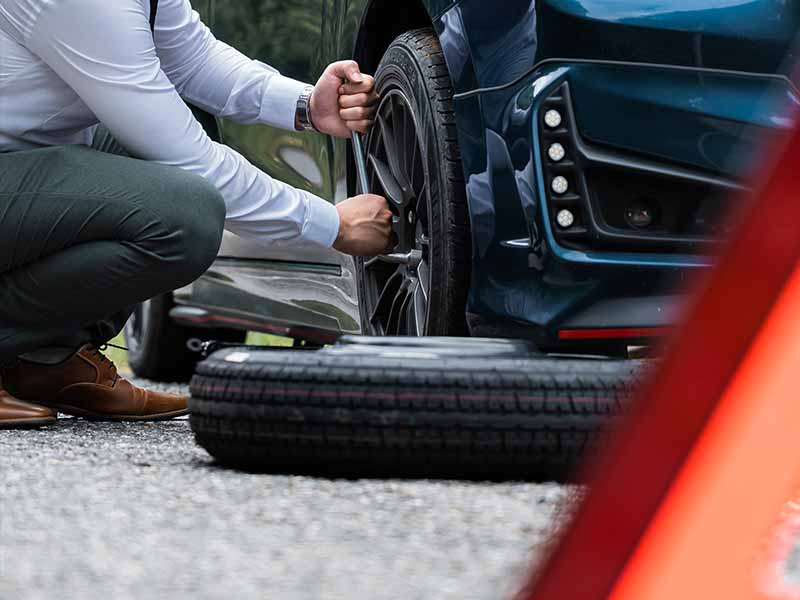Ever found yourself stranded on the side of the road with a flat tire, wondering what went wrong? You’re not alone. Flat tires are a common but avoidable headache that every driver dreads. Knowing the causes can be your first line of defense against this frustrating experience.
Flat Tire Causes
Most Common Causes of Flat Tires
- Punctures from sharp objects like nails, screws, or glass
- Wear and tear due to aging or frequent use
- Low tire pressure leading to increased friction and heat
- Overinflation causing the tire to burst
- Sudden impact with potholes, curbs, or road debris
Uncommon Causes of Flat Tires
- Valve stem issues such as damage or corrosion
- Manufacturing defects like weak rubber compounds or structural issues
- Brand new tires going flat due to improper installation or pre-existing punctures
- Slow leaks that are difficult to detect
- Environmental factors like ozone exposure or chemical spills
In this article, we’ll delve into the various causes of a flat tire, from the most common to the rare and puzzling. We’ll also discuss how to maintain proper tire pressure, the role of tire pressure monitoring systems, and what to do if a specific car tire keeps going flat.
Let’s take a closer look.

Most Common Causes of Flat Tires
Some of the most common causes of a flat car tire are quite obvious while others may not be as intuitive. Let’s thoroughly explore the com flat tire causes to help keep you safe and avoid tire blowouts.
Punctures from Sharp Objects
One of the most frequent reasons for a flat tire is a puncture caused by sharp objects like nails, screws, or glass shards. When you drive over these objects, they can penetrate the tire’s rubber, causing it to lose air.
How Punctures Happen
- Road Debris: Often, nails or glass are left on the road, posing a risk to any vehicle that passes by.
- Construction Sites: Areas near construction sites are more likely to have sharp objects scattered around.
- Off-Roading: If you’re driving on an unpaved path, the likelihood of encountering sharp rocks or other puncture-causing objects is higher.
Wear and Tear
Tires don’t last forever. Over time, the rubber wears down, making it more susceptible to flats.
Signs of Wear and Tear
- Low Tread Depth: If the tread is worn down, the tire is more vulnerable to punctures.
- Cracks in the Rubber: Look for visible cracks or cuts in the tire surface.
- Bulges or Blisters: These can indicate a weak spot that could soon become a hole.
Underinflation
Driving on tires with low air pressure can cause the tire to flatten. Underinflated tires generate more heat, which can lead to a blowout.
Why Underinflation is Risky
- Increased Friction: Low pressure means more of the tire’s surface is in contact with the road, creating friction and heat.
- Poor Handling: Underinflated tires make it difficult to steer, especially at high speeds.
- Reduced Fuel Efficiency: Your engine has to work harder to move the vehicle, consuming more fuel.
Overinflation
While less common than underinflation, overinflated tires are also problematic. They are more likely to burst, especially when hitting a pothole or other road imperfections.
Dangers of Overinflation
- Reduced Traction: Less of the tire touches the road, making it harder to control the vehicle.
- Harsh Ride: Overinflated tires make for a bumpy, uncomfortable driving experience.
- Center Wear: The middle of the tire wears out faster, requiring earlier replacement.
Sudden Causes of Flat Tires
Sometimes, a tire can go flat suddenly due to hitting a large pothole, curb, or other road hazards.
Scenarios for Sudden Flats
- Hitting a Pothole: The impact can cause immediate damage, leading to a flat.
- High-Speed Impact: Striking an object at high speeds can cause a blowout.
- Temperature Changes: Rapid changes in temperature can affect tire pressure, potentially leading to a flat.

Uncommon Causes of Flat Tires
Uncommon causes of a flat tire, such as a tire bead leak, are just as frustrating as the common causes of a flat, such as a sharp object or other unexpected debris.
Valve Stem Issues
The valve stem is the tiny protrusion from your tire that you unscrew when you need to inflate it. While it may seem insignificant, a damaged or corroded valve stem can cause your tire to lose air.
Why Valve Stems Fail
- Age: Over time, the rubber can degrade, leading to leaks.
- Damage: Physical damage can occur when you’re inflating the tire, or from hitting a curb.
- Corrosion: Metal valve stems can corrode over time, especially in areas with harsh weather conditions.
Manufacturing Defects
Though rare, some tires have manufacturing defects that can cause them to go flat. These defects can range from weak rubber compounds to structural issues like improperly aligned plies.
Identifying a Defective Tire
- Uneven Wear: If the tire wears unevenly despite regular rotation, it might be defective.
- Vibration: Unusual vibrations while driving can indicate an internal issue with the tire.
- Visible Imperfections: Bubbles, blisters, or unusual indentations can be signs of a manufacturing defect.
Brand New Tires Going Flat
It’s particularly frustrating when a brand-new tire goes flat overnight. While uncommon, this can happen due to:
- Improper Installation: If the tire isn’t seated correctly on the rim, it can lose air.
- Valve Stem Failure: Even new tires can have faulty valve stems.
- Pre-Existing Punctures: Sometimes new tires can have small punctures that went unnoticed at the time of installation.
Mysterious Cases: No Visible Puncture
Sometimes a tire keeps losing air even though there’s no visible puncture. This can be perplexing and is often due to:
- Slow Leaks: A very small object may have punctured the tire, causing a slow leak that’s hard to detect.
- Bead Leaks: The bead is where the tire seals against the rim. Sometimes, this seal can leak.
- Pinhole Leaks in the Inner Liner: These tiny leaks are difficult to spot and can cause the tire to lose air gradually.
Environmental Factors
Certain environmental factors can also contribute to flat tires, although these are less common.
- Ozone Exposure: Long-term exposure to high levels of ozone can degrade rubber.
- Chemical Spills: Accidental contact with chemicals like oil or fuel can weaken the tire rubber.

Special Cases: When Flat Tires Defy Common Logic
Just because it’s not immediately obvious what caused your car’s tire to leak air doesn’t mean it’s impossible. There are some surprising tire problems that can cause an air leak.
Tire Went Flat While Parked
It’s puzzling to find your tire flat after your car has been parked for an extended period. Here’s what could be happening:
Possible Reasons
- Temperature Drop: A significant drop in temperature can cause the air inside the tire to contract, lowering the pressure.
- Slow Leak: A slow leak might not be noticeable while driving but can cause the tire to go flat over time.
- Vandalism: Though unfortunate, sometimes tires are intentionally deflated.
Tire Went Flat Overnight but Now Holds Air
This is a perplexing scenario where the tire goes flat but seems to hold air fine after being re-inflated.
What’s Going On?
- Sealant Issues: Sometimes, the tire’s seal against the rim can be compromised but reseal itself after inflation.
- Valve Stem Anomalies: A piece of debris stuck in the valve stem can cause a leak that resolves itself upon re-inflation.
- Temperature Fluctuations: Again, significant changes in temperature can temporarily affect tire pressure.
Why Does My Right Front Tire Keep Going Flat?
If a specific tire keeps going flat, it’s a cause for concern and warrants immediate investigation.
Investigating the Issue
- Alignment Problems: If your car’s alignment is off, it can cause uneven wear on specific tires.
- Suspension Issues: Problems with the suspension can also lead to uneven tire wear.
- Recurring Punctures: Sometimes, a tire can be repeatedly punctured by debris in a specific driving environment, like your driveway or a regular route.

How to Tell if Your Tire Needs Air or Is Flat
Determining whether your tire simply needs air or is actually flat is crucial for both immediate safety and long-term maintenance. Making the wrong call can lead to further damage or even a dangerous driving situation.
Using a Tire Pressure Gauge: The Reliable Method
The most reliable way to check your tire’s condition is by using a tire pressure gauge.
Steps to Accurately Measure
- Check When Cold: For the most accurate reading, measure the tire pressure when the tire is cold.
- Remove Valve Cap: Take off the small cap on the tire’s valve stem.
- Insert Gauge: Place the gauge on the valve stem and note the reading.
- Compare to Recommended Levels: Check the owner’s manual or the sticker inside the driver’s door for the recommended PSI levels.
Visual Checks: What to Look For
Sometimes you can tell a lot just by looking at the tire.
Signs of a Flat Tire
- Completely Deflated: The tire looks visibly flat against the ground.
- Damage: You can see cuts, punctures, or protruding objects like nails.
Signs of Low Air Pressure
- Slight Bulging: The sides of the tire may bulge out a bit.
- Soft to the Touch: Pressing the tire with your hand feels softer than usual.
The “Coin Test” for Tread Depth
A simple way to check the health of your tire is the coin test, which helps you measure tread depth.
How to Perform the Coin Test
- Insert a Coin: Place a coin (like a penny) into one of the grooves on the tire’s tread.
- Check Lincoln’s Head: If you can see all of Lincoln’s head, your tread is too low, and the tire is likely unsafe.
When to Seek Professional Help
If you’re unsure about the condition of your tire or if it keeps losing air despite appearing fine, it’s time to consult a professional.
- Persistent Issues: If the tire keeps deflating, there might be a hidden issue.
- Unexplained Fluctuations: If the tire pressure is inconsistent, a professional can perform more detailed tests.
Resources
Below are some links you may find helpful when learning about tires
- Top reasons your tires go flat (& how to avoid them!) – Firestone
- 6 flat tire causes and how to prevent them – Desjardins
Final Thoughts
Understanding the causes of a flat tire is crucial for every driver. From maintaining proper tire pressure to utilizing tire pressure monitoring systems, being proactive can save you from the inconvenience of flat tires.
Remember, your car tires are more than just rubber on the road; they’re your first line of defense for a safe journey. So, whether you’re dealing with a completely flat tire or just low tire pressure, knowing the recommended tire pressure and common causes can make all the difference.
Good luck and happy motoring.




